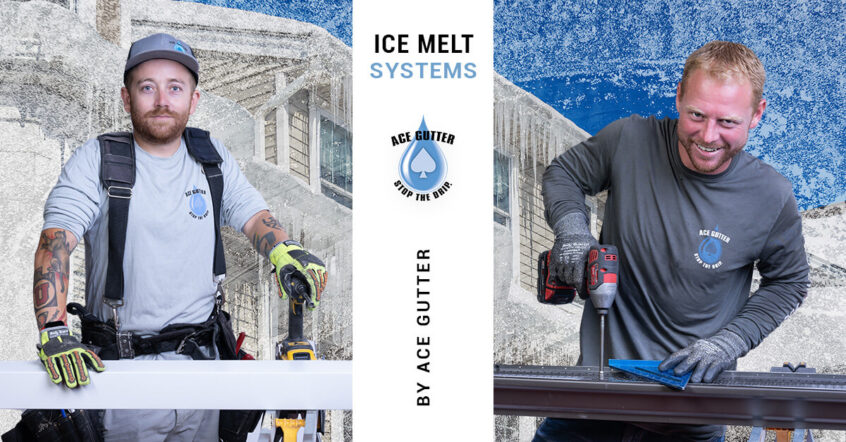Come December, with a little holiday luck, all of Utah will transform into a winter wonderland. As temperatures dip below freezing point, blankets of snow cover the entire landscape, creating an unforgettable, enchanted scene.
That said, Utah’s winters aren’t property-friendly. Heavy snowfall and freezing temperatures can quickly wreak havoc on your home, leaving you with expensive repairs for the springtime.
Of all the winter menaces threatening your home, ice dams are the worst. If left untreated, they can rip apart your roof, damage your walls, and weigh down on your gutters.
Fortunately, there are several ways to prevent ice damming. But before we jump the gun, let’s first explore the basics of ice dams and the damage they can cause.
What Is an Ice Dam?
Simply put, ice dams are thick humps of ice that form around the edges of your roof. These blockages stop water and snowmelt from flowing down your gutters and downspouts.
For starters, you may notice sparkling icicles dangling from the eaves of your roof, with piles of snow rising behind them. This is a tell-tale sign you have ice dams building up. From this initial state, the dams will continue to grow, as an increasing amount of melted snow travels down your rooftop.
At a certain point, however, the dams will become so big that the water won’t freeze anymore. Instead, the ice dams will trap the water behind them, causing it to seep through the cracks in your roof and pour into your home.
So, why do ice dams form?
Generally speaking, ice damming can be chalked up to insufficient insulation. If your attic isn’t properly insulated, the heat from inside your home will leak out into the roof. Consequently, the snow on the roof will melt and run towards the gutters, until it touches a cold section. This will cause the water to freeze again, leading to ice dam formation.
Understanding the Damage Caused by Ice Dams
Ice dams may sound benign, but they can devastate your roof in no time. To top that, it can take you a while to fix the damage they bring on.
- Besides destroying your gutters, ice dams can loosen the shingles on your roof. The dammed water backs up under those shingles and works its way into your home.
- Needless to say, it isn’t ideal to have water leaking into your walls, ceilings, and insulation. Soon enough, you’ll find yourself dealing with peeling paint, sagging ceilings, and moldy spots.
- Plus, the snow-back-up may trickle into chimneys, skylights, and other weak spots on your roof.
- In extreme cases, your roof may collapse altogether.
Once you see icicles on your gutters, take action immediately. But do not try to chip away at ice dams yourself. The safest option would be to contact a professional company that can remove them without hampering your roof.
However, to get rid of ice dams long-term, you’ll need a more permanent solution. This is where roof ice melt systems come in.
How Ice Melt Roof Systems Can Help Prevent the Damage
It can be overwhelming to see your home affected by ice dams. The good news is, it’s quite easy to prevent them.
Ice melt roof systems are your first line of defense against ice dam formation. Depending on your house’s requirements/ambient conditions, you can choose between heat tape for gutters and roof panels for maximum freeze protection.
- Heat tape is a protected electrical cord installed in gutters and pipes to keep them from freezing. Zigzag roof heating cables can be customized according to the size and complexity of your roof’s deicing needs. They are energy-efficient, resistant to overheating, and highly reliable.
Once plugged into an electrical supply, the cable warms up to prevent the melting snow from re-freezing when it reaches the roof’s overhang. As a result, the water simply falls to the ground.
- Heated roof panels are typically meant for homes located at higher elevations, as they are more susceptible to excessive snowfall. Like heating cables, they help protect your roof. As a bonus, they also enhance your home’s curb appeal.
While ice melt systems are a necessity in snowy areas, they also have a lucrative set of perks. A few benefits of roof deicing systems are as follows.
- Ice on the roof is a glaring safety hazard. Falling ice dams are heavy enough to break bones. With an ice melt system, you’ll be able to protect your family from potentially life-threatening situations.
- Ice melt roof systems indeed cost money. However, this investment is nothing when compared to repairing a heavily snow-damaged roof. Setting up a working roof deicing system will help you save on significant repair-related expenses in the future.
- As mentioned, ice dams often lead to severe instances of water damage and mildew formation. Fortunately, ice melt mechanisms can help prevent these unpleasant scenarios and extend the lifespan of your roof.
Cost of Ice Melt Roof Systems
Many homeowners shy away from ice melt roof systems because they think it’ll go beyond their budget. However, this is simply not true. Most heat tapes for gutters are reasonably priced and can protect you from potential ice damage without burning a hole through your pocket.
A few factors that influence the overall cost of a roof deicing system include:
- The size of your roof. As you would expect, larger roofs require more cable, which bumps up the cost of the project.
- The type of heating system chosen. For example, homes in colder regions will require heated roof panels or additional heavy-duty methods to effectively prevent ice dam formation.
If this is your first time choosing an ice melt roof system for your home, you should play it safe and seek professional help.
Most roofing contractors offer free estimates. They analyze your roof’s condition and the complexity of the project to determine an average cost. All you’ll have to do is book a free quote and they’ll get the process started for you.
Installation of Ice Melt Roof Systems
Heat tape for gutters is fairly easy to install, provided you’re adequately prepared. Here are a few basic steps for installing a new heating cable along your roof’s eave or gutter.
- First, secure the shingle clips to the shingles using a screwdriver. Ensure they are placed in a zigzag pattern.
- Clip the cable in the same pattern as the shingle clips.
- Form a loop with the end of the cable and push it through the downspout.
- Attach the heat sensor to the side of the house.
- Clip the moisture lead along the roof’s edge.
- Plug it into an external electrical outlet. Or, you can attach an external electrical box to the side of your home.
- Drill a hole into the sill and push the electrical wire through.
- Attach the wire into its circuit.
But if a heating cable is installed incorrectly, or if the wrong type of product is used, it can lead to a fire/electric shock hazard. Also, some ice melt roof systems, like heated panels, may require advanced technical skills.
Rather than grappling with dangerous electrical wiring yourself, you can hire a professional roofing company for the job. Being experts at roof deicing, they’ll be able to install your ice melt roof system safely and efficiently.
Conclusion
Given that Utah receives heavy snowfall in the winter, it’s in your best interest to invest in an ice melt system for your roof. Heating tapes/cables and heated roof panels can safeguard your home against ice damage, thus ensuring your peace of mind.
At Ace Gutter, we specialize in installing ice melt roof systems for commercial and residential buildings across Utah. With our effective heat tapes and heated roof panels, you won’t have to worry about ice dams tearing up your gutters anymore. Get in touch with us for a free estimate today!


